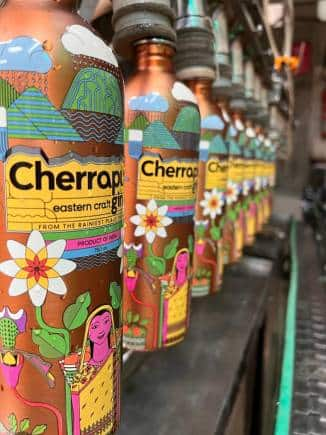



Mayukh Hazarika says he didn’t set out to make alcohol from the North-East. But each time he visited Shillong, where he hails from, he would often wonder about Cherrapunji’s immense potential as a brand and the benefits of geographical association with one of the world’s rainiest places. “It rains heavily in Mumbai, but people don’t visit it because of the rain. But nearly a million people visit Cherrapunji every year — I wanted to give them a bit of that rain,” says Hazarika, who moved to Mumbai and eventually Delhi to pursue a career in advertising and marketing about two decades ago.
 Rs 2,500 in Meghalaya, where it is made.
Rs 2,500 in Meghalaya, where it is made.
In 2022, Hazarika, a hobby distiller, pursued a course in distilling in Netherlands and once back, drew up a more concrete blueprint that ultimately led to the launch of Cherrapunji Gin in Meghalaya last month.
 Cherrapunji Gin bottling factory.
Cherrapunji Gin bottling factory.
On paper, Hazarika’s gin has a lot going for it. Its ingredients showcase the abundant wealth of the North-East — more on that later — but in using harvested — and treated — rainwater to make his gin, his company, Raincheck Earth, also draws attention to the pressing problem of a significant drop in rainfall in Cherrapunji and its surrounding areas, and of drought-like conditions in winter. The town, which reportedly received a record-book-worthy 24,555mm of annual rain in 1974, now gets 8,000 to 9,000mm of precipitation.
“The liquor industry is hugely water-intensive. You get a lot of rain in, say, Goa and Maharashtra — so why not harvest it instead of using groundwater?” says Hazarika, who sources water from two rainwater harvesting facilities, one located in his company’s distillery, near Umiam, in Shillong, and the other in Mawsynram, the world’s wettest place.
The gin is distilled in a “highly energy efficient”, square-shaped still imported from the Netherlands, and comes in a recyclable — and smashing — steel bottle, which weighs 148 grams. “It’s much lighter than a glass bottle, so you have lower carbon emissions when cases are transported. Even the volumetric weight is less compared to conventional bottles, so a truck is, on average, able to transport a lot more cases,” says Hazarika, who is quick to add that he wants the customer to buy Cherrapunji Gin not only because it’s sustainable, but also because it’s a quality product.
 Cherrapunji Gin founder Mayukh Hazarika.
Cherrapunji Gin founder Mayukh Hazarika.
The recipe was developed in collaboration with a Dutch master distiller and the botanicals that go into its making are sourced from across the North-East. Supply chains don’t exist for many of the botanicals, said Hazarika, so he tends to buy directly from the farmers. Besides juniper from Sikkim and Arunachal Pradesh, it is infused with, among others, the sweet, aromatic Khasi mandarin, fragrant peels of the Kaji Nemu (Assam lemon), cardamom from the Garo Hills in western Meghalaya, and peppercorns from the Khasi hills. And, there’s also the highly intriguing infusion of second-flush tea from the Lushai Hills in southeastern Mizoram. “I really liked the flavour of Lapsang Souchong during trials, this tea comes closest to it. It lends the gin a smoky, creamy flavour,” says Hazarika.
Cherrapunji Gin costs Rs 2,500 in Meghalaya and is scheduled to hit shelves in Delhi and Mumbai early next year.
Discover the latest Business News, Sensex, and Nifty updates. Obtain Personal Finance insights, tax queries, and expert opinions on Moneycontrol or download the Moneycontrol App to stay updated!
Find the best of Al News in one place, specially curated for you every weekend.
Stay on top of the latest tech trends and biggest startup news.